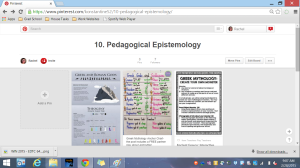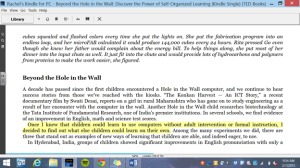As I completed reading Why School by Will Richardson (2012), I find myself ruminating on the various ideas presented in the novel and how they will impact my own approach to education. When I applied to graduate school, one of my main arguments for wanting to be a teacher was that I felt the traditional curriculum—which has worked very well for me, historically—failed to account for other kinds of learners and that that was a gap I wanted to fill. I also argued that the kinds of knowledge and skills that I wanted my students to depart with were more about being able to do something or find the information to help them do something rather than having something memorized. Therefore, reading this book has really helped solidify those beliefs. At the end of Why School, Richardson breaks down his ideas into six key points regarding what educators need to do and/or think about in order to consider and incorporate the new way the world is due to innovation and technology. For my final reflection, I shall list them and write down Richardson’s and my own thoughts about their meaning and/or significance.
- Share everything: Richardson notes that one of the first things that teachers can do to promote student learning is to share the resources that they have developed with other teachers, thereby lifting the practice of teaching as a whole. Transparency among educators would enable access to more ideas about what works and what does not work, promoting increased creativity and differentiation.
- Discover, don’t deliver, the curriculum: Rather than envisioning yourself as someone who executes lesson plans, Richardson argues for a more collaborative model between students and the teacher for learning. Teachers, too, should be trying to learn more about the world as he or she encourages his or her students to do so. Instead of delivering the known curriculum all of the time, teachers should engage with the students in a creative, collaborative process that seeks to discover, rather than deliver, knowledge.
 Talk to strangers: While there are certainly hazards in speaking with strangers online, Richardson notes that the ability to vet strangers is a skill we need to engrain in our students and children and that there is a lot of learning that can come from strangers. We do not learn a lot from people who think as we do—we learn the most from those who are different than us, those who have seen the world in a different way. Also, helping students meet and learn from strangers (for instance, perhaps an expert on the unit subject) provides a safe way to practice meeting strangers safely.
Talk to strangers: While there are certainly hazards in speaking with strangers online, Richardson notes that the ability to vet strangers is a skill we need to engrain in our students and children and that there is a lot of learning that can come from strangers. We do not learn a lot from people who think as we do—we learn the most from those who are different than us, those who have seen the world in a different way. Also, helping students meet and learn from strangers (for instance, perhaps an expert on the unit subject) provides a safe way to practice meeting strangers safely.- Be a master learner: One of the most powerful tools as a teacher is observational learning; therefore, teachers need to serve as role models for the value of and passion for learning. Also, passion is often infectious and students are in a period of their life where they are natural explorers with innate curiosity about the world. We need to model our own passion and curiosity while cultivating theirs.
- Do real work for real audiences: Rather than simply assigning projects that stay assignments, consider incorporating projects that actually produce authentic, real-world knowledge.
- Transfer the power: We need to give students real experiences that they can transfer into the “real world” rather than academic experiences that seem inapplicable to anything asked of them after they complete their compulsory education. Also, don’t necessarily primarily focus on teaching a student to know a content area – also teacher them how to learn about that content area in a meaningful way. That skill will come in far handier than a lot of other skill sets we impart on children as they make their way through their education.
This book overall resonates with my own approach to teaching. Perhaps it is the nature of working a secondary EBD program, but I truly believe that my job is to help my students learn the skills of learning in an increasingly technological world rather than the more traditional regurgitation of high schools past. I also identify very strongly with the idea that I am a role model of the value of learning—my students and I have the best rapport and learning when I am as engaged as they are, as committed to learning about something in an authentic and useful way. I also like the idea of connecting projects to a more real-world application. For instance, one of my English classes completed a project where they designed a hypothetical board or video game. However, I could connect this project to any of the many contests around the country that students submit work to. Adding that extra layer of motivation and interest would increase the likelihood of learning as well as build on skills that will be more useful in the world outside of school.
I feel like a proficient eReader user by the end of this course. I am sure that there are other features that I may come across eventually, but overall I feel as though I understand the program and navigate it easily. While I still enjoy reading books, particularly when that reading is for pleasure, I do find that the convenience of having my books with me whenever I could find space time to read was extremely useful, particularly the part where they are stored on something I was already hauling around anyway. I used the Wikipedia feature more this week, occasionally checking out the Wikipedia pages of quoted researchers or philosophers.
Richardson, Will. (2012). Why school?: How education must change when learning and information are everywhere [Kindle Single].Retrieved from Amazon.com.

 Like most registrations for apps, Pinterest is incredibly easy to set up. Once I entered a username, email, and password, there was a tutorial to learn how to use Pinterest or the option to immediately starting pinning. Another available option is to link the account to a Facebook account, thus improving the ability to share with others.
Like most registrations for apps, Pinterest is incredibly easy to set up. Once I entered a username, email, and password, there was a tutorial to learn how to use Pinterest or the option to immediately starting pinning. Another available option is to link the account to a Facebook account, thus improving the ability to share with others.



 eally useful in Behavior Self-Management, a class where students practice social and emotional skills. Having students research an idea regarding health and wellness while practicing digital literacy skills and independent learning seems like a good match. Additionally, it is a safe class to reduce the amount of scaffolding for students with regard to a task at hand.
eally useful in Behavior Self-Management, a class where students practice social and emotional skills. Having students research an idea regarding health and wellness while practicing digital literacy skills and independent learning seems like a good match. Additionally, it is a safe class to reduce the amount of scaffolding for students with regard to a task at hand.
